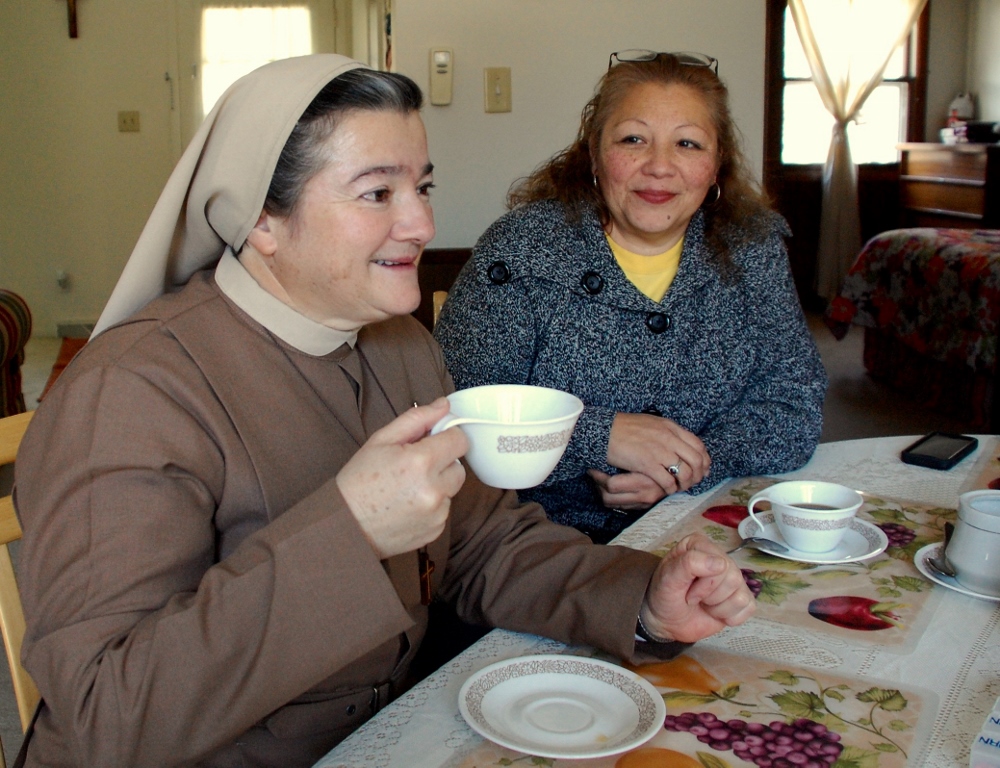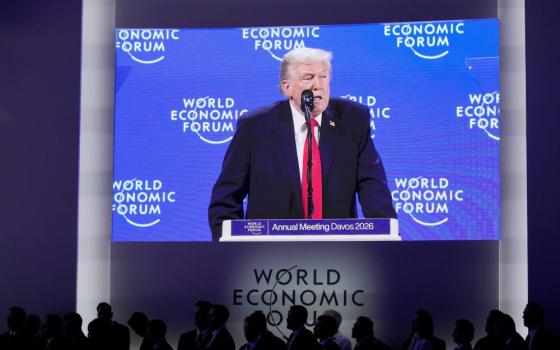
Missionary Servants of the Divine Spirit Sr. Dora Elena Orozco and local parishioner Melinda Gracia share a cup of coffee in the convent that serves the San Felipe de Jesus parish in Fennville, Michigan, in this 2016 file photo. Orozco was sent from her home in Colombia to serve Spanish-speaking people in the United States. (GSR photo/Dan Stockman)
The demand for green cards for religious workers in the United States has so outstripped supply that many sisters now in the country on temporary visas will likely see those visas run out before they can apply to stay permanently.
The U.S. State Department announced March 22 that the quota for religious workers has been so surpassed that only those who petitioned to stay permanently before 2018 would be allowed to move forward in the approval process. The five-year backlog means the five-year R-1 visas for religious workers will end, and the sisters, brothers, priests or pastors holding the visas will have to leave the country before they can apply for permanent residency.
R-1 visas can be renewed, but only after the holder spends at least one year outside the United States.
"That [announcement] was like a thunderbolt," said Miguel Naranjo, director of religious immigration services at the Catholic Legal Immigration Network, Inc., or CLINIC, which is based in Silver Spring, Maryland. "A lot of dioceses and congregations brought people here expecting them to be able to stay permanently."
Naranjo said moving from an R-1 visa to permanent residency is a two-step process. First, the sponsoring institution, such as a congregation or diocese, petitions for the change, called an adjustment of status. Once that petition is approved, the visa-holder can apply for a green card. The petitions are considered in the order they are filed; the backlog now goes back to petitions filed in September 2018.
"This is not something people are going to feel right away," Naranjo said. "We're still encouraging people to file petitions and wait in line."
Advertisement
By law, the United States can issue a maximum of 140,000 employment-based visas per year, according to the American Immigration Council, but that figure also includes workers' dependents, so the actual number of workers receiving visas is lower.
Within those 140,000 visas, there are five preference categories: workers with "extraordinary ability" in areas such as the arts or business; workers with advanced degrees; skilled workers and professionals; "special immigrants" like religious workers, employees of U.S. foreign-service posts, translators, former U.S. government employees; and people who will invest $500,000 to $1 million "in a job-creating enterprise."
For the religious workers in the fourth category, the number of visas available depends on how many are left after the first three categories use their allotment. This category is also limited by law to 9,940 visas, shrinking the number of granted visas for religious workers even further.
In fiscal year 2021, the U.S. government issued 1,942 R-1 visas; Naranjo said last year, CLINIC helped about 75 visa-holders file petitions for permanent residency.
Sr. Mary Ellen Burns, a member of the Apostles of the Sacred Heart of Jesus in New Haven, Connecticut, said the change will affect congregations with international sisters.
"Depending on where they are in their religious worker status, it could be causing problems for people right now," said Burns, an attorney at Apostle Immigrant Services, which does legal immigration work in the New Haven area. "It presents a challenge."
While visa-holders can renew a religious worker visa, Burns said it's hard to imagine a formation program that includes a one-year break to allow the sister to be out of the country for the time required for a renewal. Congregations may simply decide not to bring foreign sisters here at all.
"I would think there will be a small number of congregations who are looking at it and saying, 'Oh, never mind,' " Burns said. "I believe communities are going to look at the reality and plan accordingly."
She said dioceses and congregations of men have a little more flexibility: Because of the years of study required, a priest or brother could use a student visa while he is enrolled in college. But most women's congregations don't have those types of requirements. They might, however, decide that instead of working part-time toward a master's degree while in ministry, the sister would study full-time on a student visa and hope the backlog in converting religious worker visas dissipates.
"They could also apply from the start for permanent residency, but you may wait five years for that," Burns said. "There's a lot of different factors, and this is throwing another one in."
Naranjo said the government dragged its feet on processing petitions for several years, creating much of the backlog.
"The previous administration was not as immigration-friendly," he said. "The program did endure some challenges with processing times."
The COVID-19 pandemic made that worse, Naranjo said, but by the beginning of 2022, things started to improve. CLINIC helped about 150 people apply for green cards last year.
Because the law limits the numbers of visas that can be issued, Congress would have to get involved for things to change. The length of time the visas cover is also set by law.
Naranjo said the religious worker program is not a big immigration program, so it is normally overlooked.
"But this problem has finally gotten the program more attention," he said. "As soon as [denominations and dioceses] learn the clergy they've invested in for years is going to have to leave, they'll really see the problem."





